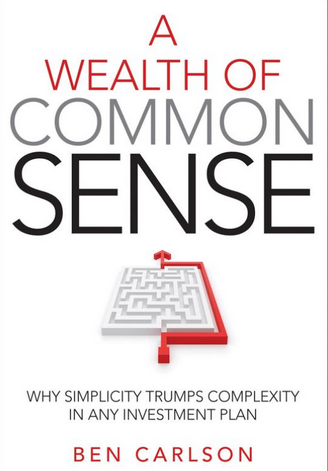Ben Carlson splashed onto the blog scene a few years ago with his hit website, aptly named, “A Wealth of Common Sense.” My initial reaction was, “Oh great, here we go again. Some kid trying to pretend they know something about finance.”
Boy, was I wrong.
Ben is the real deal and his blog, revolving around behavioral finance, has become a must read. Part of Ben’s appeal is that he writes in plain language, and in a way that makes otherwise complex topics accessible by anyone. But Ben’s latest levelheaded thoughts are not limited to his blog, Ben has a new book, A Wealth of Common Sense. Ben’s book is a great read, but what I really love about the compiled work is that is solves a genuine investor problem:
A Wealth of Common Sense will simplify your investment life!
Ben’s key insight–that simplicity trumps complexity–is powerful on many levels, and has numerous practical applications, especially when thinking about investing. In many ways, Ben has taken behavioral finance, synthesized the key learning points, and compiled it in an easy to read book. In the introduction Ben says the following:
“It will become more and more important to separate the meaningful from the meaningless…”
In an investing world dominated by strident voices pushing various agendas, and peddling solutions that sometimes simply don’t make sense, this becomes an important philosophical point of reference. But how can we go about separating the wheat from the chaff? Ben describes mental checklists that can help investors avoid investment traps that we are prone to fall into. He goes on to highlight the reason why simplicity is such a good idea:
We all like to think that more choices must be better, but as the number of choices grows…the likelihood of making a mistake [increases].
Simplicity is better because it works better. Period. That’s a tough argument to beat.
What I like about the book?
Ben’s book is filled with behavioral checklists for Do-It-Yourself (DIY) investors to follow. These are worth ruminating on and internalizing. But frankly, my favorite part of the book is the humor. Yes, it’s true, this is a finance book that made me laugh out loud on a few occasions. The humor and unpretentious style make the book more conversational in tone, giving the reader a real sense for Ben’s personality, which includes a dry wit.
Ben also conveys concepts through examples that illuminate. Some of my favorite stories involve discussions surrounding how investors perceive risk and reward, for instance, how investors view value stocks and glamour stocks. One approach to describing this would be to highlight boring academic papers (i.e., my lame approach), but Ben’s approach is much smarter, and more congenial. Ben highlights the importance of framing an investment decision in the context of an academic study where researchers ask students to eat a piece of fudge shaped like a piece of dog crap (pg. 52). If that doesn’t make you laugh, then you may be taking yourself too seriously.
Anyway, not surprisingly, students don’t want to eat fudge when it looks like a dog turd.
But why not?
Fudge should be considered a great thing if it actually is a great thing, no matter what the shape. However, that is not how the human mind works. In many respects, investing in value stocks, which are often framed as loser stocks with no redeeming qualities, is analogous to eating great-testing fudge that is in some distressing form (like a dog poop). Whereas, growth stocks are more akin to dog turds shaped as chocolate bars–yum!–everyone wants to take a bite!
Another fascinating related example is outlined later in the book on page 137. Ben describes how the power of a story can turn something worthless into something we perceive valuable. He showcases an experiment where researchers collected a bunch of garage-sale junk and then attempted to sell the goods on Ebay. The trick was to invest a lot of time and effort into telling the “story” for a particular piece of junk. Surprise, surprise, telling a great story worked! The researchers were able to sell a beat-up oven mitt for $52, and a used shot glass for $76. Not bad! Of course, the analogy is that Wall Street–and the broader financial services industry–are great at selling stories, but it is unclear if the underlying products they are selling are worth the value attributed to them by the salesman.
I won’t steal Ben’s thunder by laundry listing my other favorite stories–and there are some great ones–but these many mini-case studies throughout the book are both entertaining and help illuminate complex topics in an uncomplicated manner.
Constructive Criticism
I was looking for more explicit recommendations on how to take action. Ben’s book is not very tangible when it comes to the blocking and tackling of day-day portfolio management:
- You won’t learn how to pick stocks
- You won’t be served an asset allocation model
- You won’t learn how to time market downfalls
In fact, Ben doesn’t share any direct advice that is immediately applicable to building and managing your portfolio. And if you are looking for actionable investment advice, this isn’t the book for you.
A book that doesn’t tell us how to make millions? What’s the point?
The heading above–to be clear–is meant to be sarcastic. No book can make you an overnight millionaire. However, Ben’s book is unique in that it could actually make you a millionaire (it just may take a long time) by helping investors change their behavior. And to be frank, Ben’s book has a much higher calling than simply serving as a investment mechanic on one aspect of your portfolio. Instead, I see Ben’s book as a financial advisor that costs $20, and not 1% of your wealth each year. And depending on how much money you have, a $20 financial advisor is a pretty dang good deal.
Throughout A Wealth of Common Sense there are great checklists for DIY investors that help them make better decisions:
- A Wealth of Common Sense will teach you how to be a successful investor…
- A Wealth of Common Sense will highlight a laundry list of common market myths…
- A Wealth of Common Sense will teach you how to identify your portfolio’s mission and goals…
- A Wealth of Common Sense will show you how to pick a financial advisor…
DIY investors and financial professionals, unite…A Wealth of Common Sense offers something for everyone.
About the Author: Wesley Gray, PhD
—
Important Disclosures
For informational and educational purposes only and should not be construed as specific investment, accounting, legal, or tax advice. Certain information is deemed to be reliable, but its accuracy and completeness cannot be guaranteed. Third party information may become outdated or otherwise superseded without notice. Neither the Securities and Exchange Commission (SEC) nor any other federal or state agency has approved, determined the accuracy, or confirmed the adequacy of this article.
The views and opinions expressed herein are those of the author and do not necessarily reflect the views of Alpha Architect, its affiliates or its employees. Our full disclosures are available here. Definitions of common statistics used in our analysis are available here (towards the bottom).
Join thousands of other readers and subscribe to our blog.



